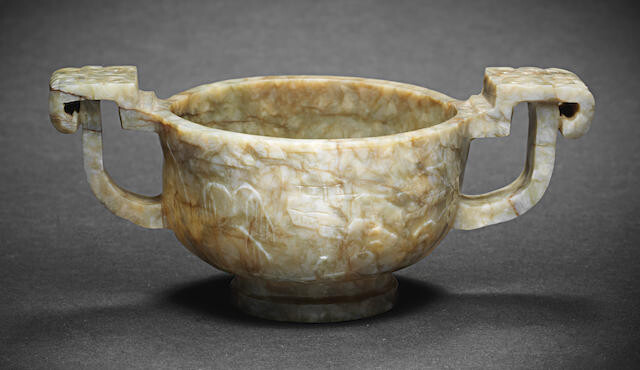A 'CHICKEN BONE' JADE TWO-HANDLED CUP
16th/17th century
16th/17th century
The vessel expertly hollowed and flanked by a pair of everted handles carved with scrollwork motifs on curved supports, the body carved on the exterior with pavilions nestling amongst pine, willow and rockwork, raised on a short foot with a flared rim, with hongmu stand. 13.2cm (5 1/4in) wide. (2).
十六/十七世紀 雞骨玉雕雙耳盃
Provenance:
K.C. Wong
Bluett & Sons Ltd., London
E. A. Parry (1879-1946), London, acquired from the above on 4 June 1930, and thence by descent
Published and Exhibited:
Bluett & Sons Ltd., The Wong Collection of Ancient Chinese Jades, London, 1930, no.434
來源:
K.C. Wong舊藏
倫敦古董商Bluett & Sons Ltd.
倫敦E. A. Parry(1879-1946)舊藏,於1928年6月4日購自上者,並由後人保存迄今
展覽著錄:
Bluett & Sons Ltd.,《The Wong Collection of Ancient Chinese Jades》,倫敦,1930年,編號434
Finely carved with a pair of handles recalling sinuous chilong and decorated with stylised taotie masks, the shape of the present cup is inspired by the archaic food vessel, gui, which stored food offerings reserved for the ancestors of the most important families of the time. The gui and ding forms were the most commonly imitated shapes during the Ming dynasty, when they served as incense burners or water holders for the scholar's table. Their form and decoration clearly underscored the literati's fascination with the past and its intrinsic values of harmony and simplicity.
The present cup's subject matter recalls the literati's longing to commune with nature where they forged their identity as poets, philosophers and calligraphers, away from the mundane world of political affairs.
Compare with two related jade two-handled cups, 16th/17th century, in the British Museum, London, illustrated by J.Rawson, Chinese Jades from the Neolithic to the Qing, London, 1995, p.388, fig.8.
A related green jade two-handled cup, Ming dynasty, was sold at Sotheby's New York, 19 March 2019, lot 208.
造型典雅秀麗,兼具古樸之風。器身造型源自商周青銅器簋,器耳由蜿蜒盤踞的螭龍演化而來,並飾以風格化的饕餮紋。器身浮雕庭園松石景緻,頗為別緻,觀者可寄情於景,超然物外。
明代仿古器多以青銅器為原型。商周的簋形器,往往與鼎成組相配,作為標誌貴族等級身份的禮器。至明時,已成為仿古器中最為常見的造型,用於文人案頭作為貯放香料的香薰或水丞。
參考倫敦大英博物館館藏兩例十六/十七世紀玉雙耳盃,收錄於J.Rawson著,《Chinese Jades from the Neolithic to the Qing》,倫敦,1995年,頁388,圖版8。另見一例明碧玉雕簋式爐,售於紐約蘇富比,2019年3月19日,拍品編號208。
View it on
Sale price
Estimate
Time, Location
Auction House
16th/17th century
16th/17th century
The vessel expertly hollowed and flanked by a pair of everted handles carved with scrollwork motifs on curved supports, the body carved on the exterior with pavilions nestling amongst pine, willow and rockwork, raised on a short foot with a flared rim, with hongmu stand. 13.2cm (5 1/4in) wide. (2).
十六/十七世紀 雞骨玉雕雙耳盃
Provenance:
K.C. Wong
Bluett & Sons Ltd., London
E. A. Parry (1879-1946), London, acquired from the above on 4 June 1930, and thence by descent
Published and Exhibited:
Bluett & Sons Ltd., The Wong Collection of Ancient Chinese Jades, London, 1930, no.434
來源:
K.C. Wong舊藏
倫敦古董商Bluett & Sons Ltd.
倫敦E. A. Parry(1879-1946)舊藏,於1928年6月4日購自上者,並由後人保存迄今
展覽著錄:
Bluett & Sons Ltd.,《The Wong Collection of Ancient Chinese Jades》,倫敦,1930年,編號434
Finely carved with a pair of handles recalling sinuous chilong and decorated with stylised taotie masks, the shape of the present cup is inspired by the archaic food vessel, gui, which stored food offerings reserved for the ancestors of the most important families of the time. The gui and ding forms were the most commonly imitated shapes during the Ming dynasty, when they served as incense burners or water holders for the scholar's table. Their form and decoration clearly underscored the literati's fascination with the past and its intrinsic values of harmony and simplicity.
The present cup's subject matter recalls the literati's longing to commune with nature where they forged their identity as poets, philosophers and calligraphers, away from the mundane world of political affairs.
Compare with two related jade two-handled cups, 16th/17th century, in the British Museum, London, illustrated by J.Rawson, Chinese Jades from the Neolithic to the Qing, London, 1995, p.388, fig.8.
A related green jade two-handled cup, Ming dynasty, was sold at Sotheby's New York, 19 March 2019, lot 208.
造型典雅秀麗,兼具古樸之風。器身造型源自商周青銅器簋,器耳由蜿蜒盤踞的螭龍演化而來,並飾以風格化的饕餮紋。器身浮雕庭園松石景緻,頗為別緻,觀者可寄情於景,超然物外。
明代仿古器多以青銅器為原型。商周的簋形器,往往與鼎成組相配,作為標誌貴族等級身份的禮器。至明時,已成為仿古器中最為常見的造型,用於文人案頭作為貯放香料的香薰或水丞。
參考倫敦大英博物館館藏兩例十六/十七世紀玉雙耳盃,收錄於J.Rawson著,《Chinese Jades from the Neolithic to the Qing》,倫敦,1995年,頁388,圖版8。另見一例明碧玉雕簋式爐,售於紐約蘇富比,2019年3月19日,拍品編號208。



